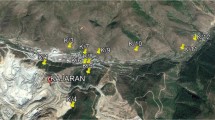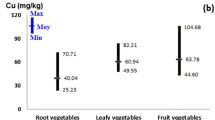Abstract
Human exposure to trace elements has been a large concern due to the potential health issues. Accordingly, this study aimed to compare the concentrations of arsenic, copper, and zinc in the edible parts of vegetables grown in a mining-agricultural area and in an exclusively agricultural area and to compare the potential human health risks of consuming vegetables from both areas. The consumption habits of the studied population were extracted from the 2010 National Alimentary Survey of Chile. In most cases, the concentrations of trace elements in the edible tissues of vegetables (lettuce, spinach, garlic, onion, carrot, potato, sweet corn, and tomato) were higher in the mining-agricultural area than those in the control area. This difference was most pronounced for leafy vegetables, with arsenic being the trace element of concern. Specifically, the arsenic concentrations in the edible tissues of lettuce and spinach were 8.2- and 5.4-fold higher, respectively, in the mining-agricultural area than in the control area. Lettuce was the vegetable of concern due to its relatively high consumption and relatively high concentration of trace elements. Nevertheless, there was no health risk associated with vegetable consumption in either the mining area or the control area because none of the HQ values surpassed 1.0.


Similar content being viewed by others
References
Aguilar R, Hormazábal C, Gaete H, Neaman A (2011) Spatial distribution of copper, organic matter and pH in agricultural soils affected by mining activities. J Soil Sci Plant Nutr 11:125–145
Ahumada I, Escudero P, Ascar L, Mendoza J, Richter P (2004) Extractability of arsenic, copper, and lead in soils of a mining and agricultural zone in central Chile. Commun Soil Sci Plant Anal 35:1615–1634
Alloway BJ (2013) Heavy metals and metalloids as micronutrients for plants and animals. In: Alloway JB (ed) Heavy metals in soils: trace metals and metalloids in soils and their bioavailability. Springer Netherlands, Dordrecht, pp 195–209
Amin NU, Hussain A, Alamzeb S, Begum S (2013) Accumulation of heavy metals in edible parts of vegetables irrigated with waste water and their daily intake to adults and children, District Mardan, Pakistan. Food Chem 136:1515–1523
Amir R, Anjum F, Randhawa M, Abbas S, Saeed M (2016) Confiscation of heavy metal residues in cauliflower using washing solutions. Qual Assur Safety of Crops Foods 8:379–383
Arao T, Ishikawa S, Murakami M, Abe K, Maejima Y, Makino T (2010) Heavy metal contamination of agricultural soil and countermeasures in Japan. Paddy Water Environ 8:247–257
Ávila PF, Ferreira da Silva E, Candeias C (2016) Health risk assessment through consumption of vegetables rich in heavy metals: the case study of the surrounding villages from Panasqueira mine, Central Portugal. Environ Geochem Health:1–25
BCN (2012): Reporte estadístico comunal 2012: Catemu. Biblioteca del Congreso Nacional de Chile
CCME (1999a) Canadian soil quality guidelines for the protection of environment and human health: copper. Canadian council of ministers of the environment, Winnipeg
CCME (1999b) Canadian soil quality guidelines for the protection of environment and human health: zinc. Ministers of the Environment, Canadian Council of
CCME 2001: Canadian soil quality guidelines for the protection of environment and human health: arsenic (inorganic), Canadian Council of Ministers of the Environment, Winnipeg
De Gregori I, Fuentes E, Rojas M, Pinochet H, Potin-Gautier M (2003) Monitoring of copper, arsenic and antimony levels in agricultural soils impacted and non-impacted by mining activities, from three regions in Chile. J Environ Monit 5:287–295
Díaz OP, Leyton I, Muñoz O, Núñez N, Devesa V, Súñer MA, Vélez D, Montoro R (2004) Contribution of water, bread, and vegetables (raw and cooked) to dietary intake of inorganic arsenic in a rural village of Northern Chile. J Agric Food Chem 52:1773–1779
EU (2006) Setting maximum levels for certain contaminants in foodstuffs. Union, European
FAO (1995) General standard for contaminants and toxins in food and feed (codex stan 193–1995, adopted in 1995, last revised in 2009, last amended in 2015). Organization of the United Nations, Food and Agriculture
Folchi M (2006) Major smelters and air pollution: Chagres and Ventanas, 1959–2006, environmental history of the profit work in copper mining in Chile, 19th and 20th centuries. Universitat autónoma de Barcelona, Barcelona
Ginocchio R, Sánchez P, De La Fuente LM, Camus I, Bustamante E, Silva Y, Urrestarazu P, Torres JC, Rodríguez PH (2006) Agricultural soils spiked with copper mine wastes and copper concentrate: implications for copper bioavailability and bioaccumulation. Environ Toxicol Chem 25:712–718
Ginocchio R, de la Fuente LM, Sánchez P, Bustamante E, Silva Y, Urrestarazu P, Rodríguez PH (2009) Soil acidification as a confounding factor on metal phytotoxicity in soils spiked with copper-rich mine wastes. Environ Toxicol Chem 28:2069–2081
González M, Bergqvist A, Ite D (1984) Heavy-metal pollution of an area near a copper smelter in Chile. Catemu V Region Agricultura Tecnica (Chile) 43:63–68
Gupta N, Khan DK, Santra SC (2012) Heavy metal accumulation in vegetables grown in a long-term wastewater-irrigated agricultural land of tropical India. Environ Monit Assess 184:6673–6682
Haynes RJ, Naidu R (1998) Influence of lime, fertilizer and manure applications on soil organic matter content and soil physical conditions: a review. Nutr Cycl Agroecosyst 51:123–137
Hu W, Chen Y, Huang B, Niedermann S (2014) Health risk assessment of heavy metals in soils and vegetables from a typical greenhouse vegetable production system in China. Human Ecol Risk Assess: An Int J 20:1264–1280
INE (2002) Chile: proyecciones estimadas de población. Total país. Instituto Nacional de Estadísticas de Chile, Santiago, pp 1950–2050
INE (2007) Censo Silvoagropecuario 2007, resultados por comuna. Instituto Nacional de Estadísticas de Chile, Santiago
Islam MS, Ahmed MK, Habibullah-Al-Mamun M, Raknuzzaman M, Ali MM, Eaton DW (2016): Health risk assessment due to heavy metal exposure from commonly consumed fish and vegetables. Environ and Decis, 1–13
Kabata-Pendias A (2011): Trace elements in soils and plants. CRC Press, pp. 534
Kalra Y (1997): Handbook of reference methods for plant analysis. CRC Press, Boca Raton, pp. 320
Khan A, Khan S, Khan MA, Qamar Z, Waqas M (2015) The uptake and bioaccumulation of heavy metals by food plants, their effects on plants nutrients, and associated health risk: a review. Environ Sci Pollut Res 22:13772–13799
Lion GN, Olowoyo JO (2013) Population health risk due to dietary intake of toxic heavy metals from Spinacia oleracea harvested from soils collected in and around Tshwane, South Africa. S Afr J Bot 88:178–182
Maxwell JA (1968) Rock and mineral analysis. Interscience Publishers, New York
McBride M (1994) Environmental chemistry of soils. Oxford University Press Inc, New York
McBride M (2013): Arsenic and lead uptake by vegetable crops grown on historically contaminated orchard soils. Appl Environ Soil Sci 2013
Merlet H, D'Etigny M (1989): Requerimientos de clima y suelo: chacras y hortalizas
MINSAL (1997) Reglamento sanitario de los alimentos. Ministerio de Salud de Chile, Santiago
MINSAL (2010) Base de datos cuantificada de consumo individual. Ministerio de Salud de Chile, Santiago
Muñoz O, Diaz OP, Leyton I, Nuñez N, Devesa V, Súñer MA, Vélez D, Montoro R (2002) Vegetables collected in the cultivated Andean area of northern Chile: total and inorganic arsenic contents in raw vegetables. J Agric Food Chem 50:642–647
Noli F, Tsamos P (2016) Concentration of heavy metals and trace elements in soils, waters and vegetables and assessment of health risk in the vicinity of a lignite-fired power plant. Sci Total Environ 563:377–385
Park J-H, Choi K-K (2013) Risk assessment of the abandoned Jukjeon metal mine in South Korea following the Korean guidelines. Hum Ecol Risk Assess: An Int J 19:754–766
PGS (2015) Muestreo de suelos para las comunas de Quintero y Puchuncaví: reporte final. Ministerio del Medioambiente de Chile, Santiago
Roba C, Roşu C, Piştea I, Ozunu A, Baciu C (2016) Heavy metal content in vegetables and fruits cultivated in Baia Mare mining area (Romania) and health risk assessment. Environ Sci Pollut Res 23:6062–6073
Santibañez F, Uribe JM (1990) Agroclimatic atlas of Chile: V and metropolitan regions. National Fund for Scientific and Technological Development, Santiago
Sauvé S, Cook N, Hendershot WH, McBride MB (1996) Linking plant tissue concentrations and soil copper pools in urban contaminated soils. Environ Pollut 94:153–157
Sauvé S (2006) Copper inhibition of soil organic matter decomposition in a seventy-year field exposure. Environ Toxicol Chem 25:854–857
Scheinberg IH (1979) Human health effects of copper, chapter 2 from copper in the environment—part II: health effects. Books:17–31
SERNAGEOMIN (2016) Atlas Geológico y Minero. Servicio Nacional de Geología y Minería, Santiago
Sheldrick BH, Wang C (1993) Particle size distribution. In: Carter M (ed) Soil sampling and methods of analysis. Canadian Society of Soil Science. Lewis Publishers., Boca Raton, FL, USA, pp 499–511
Shen F, Liao R, Ali A, Mahar A, Guo D, Li R, Xining S, Awasthi MK, Wang Q, Zhang Z (2017) Spatial distribution and risk assessment of heavy metals in soil near a Pb/Zn smelter in Feng County, China. Ecotoxicol Environ Saf 139:254–262
Shi Y-Z, Ruan J-Y, Ma L-F, Han W-Y, Wang F (2008) Accumulation and distribution of arsenic and cadmium by tea plants. J Zhejiang Univ Sci B 9:265–270
Smith E, Juhasz A, Weber J (2009) Arsenic uptake and speciation in vegetables grown under greenhouse conditions. Environ Geochem Health 31:125–132
Soudek P, Petrová Š, Vaněk T (2011) Heavy metal uptake and stress responses of hydroponically cultivated garlic (Allium sativum L.). Environ Exp Bot 74:289–295
Sparks DL, Page AL, Helmke PA, Loeppert RH, Soltanpour PN, Tabatabai MA, Johnson CT, Sumner ME (1996): Methods of soil analysis. Part III: Chemical Methods. Soil Science Society of America. American Society of Agronomy, Madison, WI, USA
Steubing L (1982) Problems of bioindication and the necessity of standarization. In: Steubing L, Jäger H (eds) Monitoring air pollutants by plants. Dr. Junk Publishers, The Netherlands, pp 19–27
Turnlund JR (1998) Human whole-body copper metabolism. Am J Clin Nutr 67:960S–964S
USEPA 1989: Risk Assessment Guidance for Superfund. Volume I: Human Health Evaluation Manual (Part A), U.S. Environmental Protection Agency
USEPA 2011: Exposure factors handbook 2011 edition (final), U. S. Environmental Protection Agency, Washington, DC
USGS (2016) Mineral commodity summaries 2016. U.S. Geological Survey, Virginia
Verlinden M (1982) On the acid decomposition of human blood and plasma for the determination of selenium. Talanta 29:875–882
Zhuang P, Lu H, Li Z, Zou B, McBride MB (2014) Multiple exposure and effects assessment of heavy metals in the population near mining area in South China. PLoS One 9:e94484
Acknowledgements
This research was funded by Anglo American Sur S.A., contract number 31500081. The publication of the article was authorized on July 4, 2017, reference number S-AAS602-0717-0416.
Author information
Authors and Affiliations
Corresponding author
Additional information
Responsible editor: Philippe Garrigues
Highlights
Leafy vegetables exhibited the highest TE content in tissues.
Arsenic was the TE of greatest concern.
Local alimentary habits are a key factor for health risk assessments.
None of the HQ values surpassed 1.0.
There was no health risk associated with vegetable consumption in any of the studied areas.
Electronic supplementary material
ESM 1
(DOCX 51 kb)
Rights and permissions
About this article
Cite this article
Aguilar, M., Mondaca, P., Ginocchio, R. et al. Comparison of exposure to trace elements through vegetable consumption between a mining area and an agricultural area in central Chile. Environ Sci Pollut Res 25, 19114–19121 (2018). https://doi.org/10.1007/s11356-018-2116-x
Received:
Accepted:
Published:
Issue Date:
DOI: https://doi.org/10.1007/s11356-018-2116-x




